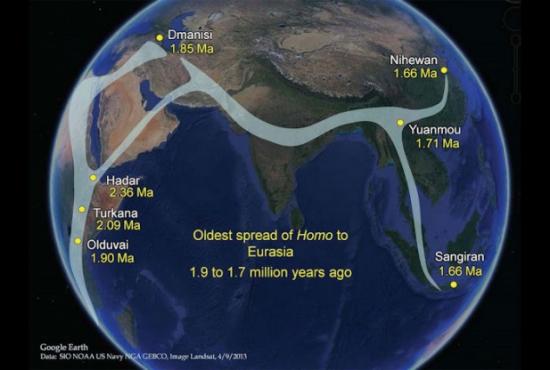Brett Smith
Source - http://www.redorbit.com/news/science/1113185110/human-evolution-patchwork-climate-patterns-070414/

A large brain, long legs, the ability to craft tools and prolonged maturation periods were all thought to have evolved together at the start of the Homo lineage in response to the Earth’s changing climate; however, scientists now have evidence that these traits arose separately rather than as a single package. In July 2014, Smithsonian paleoanthropologist Richard Potts and a team of researchers analyzed new scientific data and concluded that the ability of early humans to adjust to changing conditions ultimately enabled the earliest species of Homo to vary, survive and begin spreading from Africa to Eurasia 1.85 million years ago. Credit: Antón, Potts and Aiello (2014), Science 345(6192).
In the past, scientists concluded many of man’s defining qualities, such as legs made for walking upright and a large brain, evolved all at once. But according to a new study in the journal Science, shifts in climate caused these qualities to evolve separately.
Based on analyses of fossil evidence, the study researchers said the shrinking of forests and expansion of savannas in East Africa led to walking upright, which freed our forebears’ hands up for the creation and use of stone tools.
“Unstable climate conditions favored the evolution of the roots of human flexibility in our ancestors,” said study author Richard Potts, curator of anthropology and director of the Human Origins Program at the Smithsonian’s National Museum of Natural History. “The narrative of human evolution that arises from our analyses stresses the importance of adaptability to changing environments, rather than adaptation to any one environment, in the early success of the genus Homo.”
The study team found the predecessors of Homo erectus didn’t evolve in a series of progressively advanced iterations. Instead, a patchwork of at least three species lived alongside each other and the evolution of these species was driven by long-term climate factors in the region.
“We really were extremely lucky to have made it,” study author Leslie Aiello, a paleontologist at the Wenner-Gren Foundation, told National Geographic. “We evolved to be the best at adapting to changing conditions.”
According to the study, both Homo rudolfensis and Homo habilis – two pre-human species – share features with Homo erectus, such as skull, teeth, and jaw shapes. The study also noted the recently-discovered Australopithecus sediba, a bipedal species with apelike arms and a small brain that lived around two million years ago, had several human-like qualities.
“What we consider as ‘modern’ traits seem to have been assembled piecemeal in Africa over a long period of time,” said Chris Stringer, a paleoanthropologist at London’s Museum of Natural History, who was not on the study team.
“We can tell the species apart based on differences in the shape of their skulls, especially their face and jaws, but not on the basis of size,” said study author Susan Antón, professor of anthropology at New York University. “The differences in their skulls suggest early Homo divvied up the environment, each utilizing a slightly different strategy to survive.”
The researchers said these pre-humans were successful because they didn’t specialize, but instead became more diversified in their diet. In addition to looking at fossil and climate data for the time, the study team also looked at primitive stone tools and radioactive analyses of pre-human teeth.
“Taken together, these data suggest that species of early Homo were more flexible in their dietary choices than other species,” Aiello said. “Their flexible diet—probably containing meat—was aided by stone tool-assisted foraging that allowed our ancestors to exploit a range of resources.
“If you are a specialist and your food goes away, you die,” Aiello explained. “If you can change what you eat, you can muck through.”